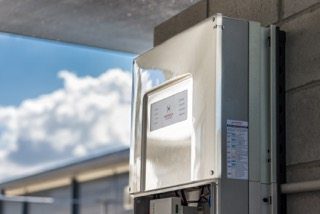EnergyAustralia has poured nearly $10 million into Brisbane-based energy management company Redback Technologies as part of a newly announced partnership that will see the retailer offer customers a web-based smart energy platform to better manage their consumption of both grid and rooftop solar electricity.
The $9.3 million deal, announced at the All-Energy Australia conference in Melbourne on Tuesday, will promote the Redback Generation 2 Smart Hybrid Solar Inverter System to EnergyAustralia’s 1.7 million customers in Victoria, New South Wales, Queensland, the ACT and South Australia.

It is the first major initiatives of the newly established New Energy division from EnergyAustralia, and follows similar investments in new technologies from its major utility rivals. It sees the technology as the launching pad for new innovations such as peer-to-peer trading, where households sell electricity to each other rather than back to the grid.
The inverter includes Redback’s cloud enabled intelligent system for analytics and remote control, the Ouija Board, which gives homeowners and commercial users energy management options through a smart device.
The technology uses machine learning to gather intelligence over time, learning from user preferences as well as drawing data from external factors like the weather.
As well as allowing non-solar customers to better use electricity and appliances more efficiently, the technology aims to bring the environmental and economic benefits of rooftop solar – and battery storage – to more Australian homes in the coming months.
Redback, which is rapidly transforming itself from a energy storage hardware company to an energy management software company, says it was chosen by EnergyAustralia for the investment due to its experience and achievements in both of those areas.
Redback’s solar inverter system is scalable, easy to install – about an hour’s work for a qualified electrician, according to EnergyAustralia – and offers what Redback says is a faster return on investment than other competitors in the market.
The software platform can be run from a smart phone and is also battery and solar panel agnostic, which means it works with existing systems.
Redback’s founder and managing director Philip Livingston says the investment will grow the company’s Australian team exponentially – with 80 per cent of the new jobs created in Brisbane – and allow it to continue developing smarter technologies.
“We’ll be hiring effectively a developer a week, or more,” Livingston told RE on the sidelines of the conference on Tuesday.
“We”re currently a team of 27 in Australia and about 5 overseas and … we’ll be consistently growing from now on.
“As a start-up you have limited ability to bring change to a market because you’re under-resourced. …Having a conversation with (EnergyAustralia) was a natural step.
“Our partnership with EnergyAustralia significantly accelerates Redback’s technology roadmap and strategic plan for leading the disruptive change required for mass adoption of renewables,” Livingston said.
“EnergyAustralia’s got millions of customers and they’re as committed as we are about bringing the change that we want to see in the grid, to the grid.
“This is all about, effectively, building out …our software roadmap, that brings in a range of technologies that … underpin the transformation of the grid from relying on centralisation to decentralised renewables.
“It’s also giving the consumer greater choice in where they source their energy and how, and making that process seamless,” he said.
“The technologies that we’re building put the consumers first in having ultimate choice in how they use their system and providing a much better degree of optimisation of self-consumption and utilisation of smarts in the home and aggregate smarts between devices outside the home.”
Andrew Perry, EnergyAustralia Executive – NextGen, said the investment reflected the energy retailer’s commitment to giving consumers more control over their energy consumption in ways that help households save money and reduce carbon emissions.
“We know electricity costs are a concern for many households and the ability to manage consumption is a key to keeping bills low,” he said.
“For us, this was always an investment around giving out customers the ability to take control and manage their own energy consumption and usage and do it in an affordable way.
“With the Redback system the customer can make the most of the energy captured on their own roof tops – they decide if they want to use the energy right away, store that energy or even sell it to the electricity grid.”
In the future, he told RE at the conference, it would offer solar customers peer-to-peer trading opportunities, as well as opportunities to sell their solar energy back to the grid.
“The thing about this is that the technology and the solution software is simple and can be updated and programmed remotely, which the Redbank team will do.
“And the customer data is clearly important to us, to see how they’re using their appliances, how efficient they are, to help them become more efficient.
“It’s also smart enough, in terms of the software, that it can pick up weather forecasts and weather patterns, to optimise …energy management.
For the customer, he says, this means they’re saving money by using their solar more optimally, and they don’t need to spend so much money on big battery systems.
“They can invest less and be much more efficient, and then, because it’s plug and play they can add another battery whenever they want.”










